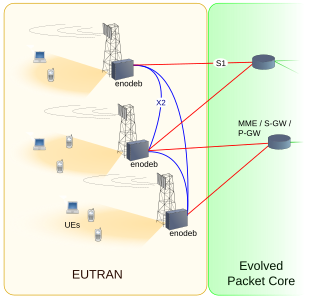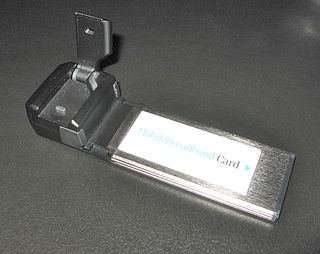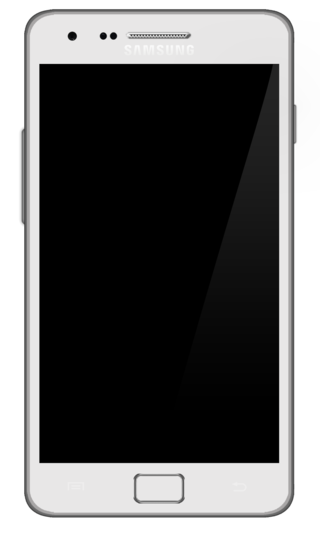The Universal Mobile Telecommunications System (UMTS) is a third generation mobile cellular system for networks based on the GSM standard. Developed and maintained by the 3GPP, UMTS is a component of the International Telecommunication Union IMT-2000 standard set and compares with the CDMA2000 standard set for networks based on the competing cdmaOne technology. UMTS uses wideband code-division multiple access (W-CDMA) radio access technology to offer greater spectral efficiency and bandwidth to mobile network operators.

Bell Mobility Inc. is a Canadian wireless network operator and the division of Bell Canada which offers wireless services across Canada. It operates networks using LTE and HSPA+ on its mainstream networks. Bell Mobility is the third-largest wireless carrier in Canada, with 10.1 million subscribers as of Q3 2020.
4G is the fourth generation of broadband cellular network technology, succeeding 3G and preceding 5G. A 4G system must provide capabilities defined by ITU in IMT Advanced. Potential and current applications include amended mobile web access, IP telephony, gaming services, high-definition mobile TV, video conferencing, and 3D television.

Evolution-Data Optimized is a telecommunications standard for the wireless transmission of data through radio signals, typically for broadband Internet access. EV-DO is an evolution of the CDMA2000 (IS-2000) standard which supports high data rates and can be deployed alongside a wireless carrier's voice services. It uses advanced multiplexing techniques including code-division multiple access (CDMA) as well as time-division multiplexing (TDM) to maximize throughput. It is a part of the CDMA2000 family of standards and has been adopted by many mobile phone service providers around the world particularly those previously employing CDMA networks. It is also used on the Globalstar satellite phone network.

E-UTRA is the air interface of 3rd Generation Partnership Project (3GPP) Long Term Evolution (LTE) upgrade path for mobile networks. It is an acronym for Evolved UMTS Terrestrial Radio Access, also known as the Evolved Universal Terrestrial Radio Access in early drafts of the 3GPP LTE specification. E-UTRAN is the combination of E-UTRA, user equipment (UE), and a Node B.

High Speed Packet Access (HSPA) is an amalgamation of two mobile protocols—High Speed Downlink Packet Access (HSDPA) and High Speed Uplink Packet Access (HSUPA)—that extends and improves the performance of existing 3G mobile telecommunication networks using the WCDMA protocols. A further-improved 3GPP standard called Evolved High Speed Packet Access was released late in 2008, with subsequent worldwide adoption beginning in 2010. The newer standard allows bit rates to reach as high as 337 Mbit/s in the downlink and 34 Mbit/s in the uplink; however, these speeds are rarely achieved in practice.

Mobile broadband is the marketing term for wireless Internet access via mobile networks. Access to the network can be made through a portable modem, wireless modem, or a tablet/smartphone or other mobile device. The first wireless Internet access became available in 1991 as part of the second generation (2G) of mobile phone technology. Higher speeds became available in 2001 and 2006 as part of the third (3G) and fourth (4G) generations. In 2011, 90% of the world's population lived in areas with 2G coverage, while 45% lived in areas with 2G and 3G coverage. Mobile broadband uses the spectrum of 225 MHz to 3700 MHz.

Evolved High Speed Packet Access, HSPA+, HSPA (Plus) or HSPAP, is a technical standard for wireless broadband telecommunication. It is the second phase of HSPA which has been introduced in 3GPP release 7 and being further improved in later 3GPP releases. HSPA+ can achieve data rates of up to 42.2 Mbit/s. It introduces antenna array technologies such as beamforming and multiple-input multiple-output communications (MIMO). Beam forming focuses the transmitted power of an antenna in a beam towards the user's direction. MIMO uses multiple antennas at the sending and receiving side. Further releases of the standard have introduced dual carrier operation, i.e. the simultaneous use of two 5 MHz carriers. HSPA+ is an evolution of HSPA that upgrades the existing 3G network and provides a method for telecom operators to migrate towards 4G speeds that are more comparable to the initially available speeds of newer LTE networks without deploying a new radio interface. HSPA+ should not be confused with LTE though, which uses an air interface based on orthogonal frequency-division modulation and multiple access.

MediaTek Inc. is a Taiwanese fabless semiconductor company that provides chips for wireless communications, high-definition television, handheld mobile devices like smartphones and tablet computers, navigation systems, consumer multimedia products and digital subscriber line services as well as optical disc drives.
In telecommunications, long-term evolution (LTE) is a standard for wireless broadband communication for mobile devices and data terminals, based on the GSM/EDGE and UMTS/HSPA standards. It improves on those standards' capacity and speed by using a different radio interface and core network improvements. LTE is the upgrade path for carriers with both GSM/UMTS networks and CDMA2000 networks. Because LTE frequencies and bands differ from country to country, only multi-band phones can use LTE in all countries where it is supported.
International Mobile Telecommunications-Advanced are the requirements issued by the ITU Radiocommunication Sector (ITU-R) of the International Telecommunication Union (ITU) in 2008 for what is marketed as 4G mobile phone and Internet access service.

Icera Inc. is a British multinational fabless semiconductor company headquartered in Bristol, United Kingdom, and a wholly owned subsidiary of Nvidia Corporation. It has developed soft modem chipsets for the mobile devices market, including mobile broadband datacards, USB sticks, and embedded modems for smartphones, laptops, netbooks, tablets, e-books and other mobile broadband devices.
Sony Semiconductor Israel Ltd., formerly known as Altair Semiconductor, is an Israeli developer of high performance single-mode Long Term Evolution (LTE) chipsets. The company's product portfolio includes baseband processors, RF transceivers and a range of reference hardware products. Founded in 2005, Altair employs 190 employees in its Hod Hasharon, Israel headquarters and R&D center, and has regional offices in the United States, Japan, China, India, Finland, and France. Altair Semiconductor was the first chipset vendor to receive certification from Verizon Wireless to run on its 4G LTE network. Altair has also powered several devices launched on Verizon's network including the Ellipsis 7 tablet and HP Chromebook 11.6"LTE. In January 2016, it was announced that Sony was acquiring Altair for $212 Million. Altair was renamed Sony Semiconductor Israel on March 29, 2020.

The Samsung Galaxy S II is a touchscreen-enabled, slate-format Android smartphone designed, developed, and marketed by Samsung Electronics, as the second smartphone of the Samsung Galaxy S series. It has additional software features, expanded hardware, and a redesigned physique compared to its predecessor, the Samsung Galaxy S. The S II was launched with Android 2.3.4 "Gingerbread", with updates to Android 4.1.2 "Jelly Bean".

The Samsung Exynos, formerly Hummingbird (Korean: 엑시노스), is a series of ARM-based system-on-chips developed by Samsung Electronics' System LSI division and manufactured by Samsung Foundry. It is a continuation of Samsung's earlier S3C, S5L and S5P line of SoCs.
The E5 is a mobile Wi-Fi device produced by Huawei Technologies, and is part of the company's mobile Wi-Fi series that includes the E5830s, E585, E583c and E586. The E5 series connect to other devices using a wireless interface. The devices are pocket size and allow users to access the Internet through any Wi-Fi device, mobile phone, game console, digital camera, notebook and personal digital assistant (PDA).

The Samsung Galaxy Note II is an Android phablet smartphone. Unveiled on August 29, 2012 and released in October 2012, the Galaxy Note II is a successor to the original Galaxy Note, incorporating improved stylus functionality, a larger 5.5-inch (140 mm) screen, and an updated hardware and casing design based on that of the Galaxy S III.
The Intel XMM modems are a series of 4G LTE, LTE Advanced, LTE Advanced Pro and 5G modems found in many phones, tablets, laptops and wearables developed by Intel Mobile Communications. Intel Mobile Communications was formed after Intel acquired the Wireless Solutions (WLS) division of Infineon early in 2011 for US$1.4 billion.














